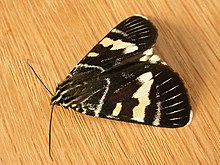
Caterpillars are the larval stage of members of the order Lepidoptera.

The Pterophoridae or plume moths are a family of Lepidoptera with unusually modified wings. Though they belong to the Apoditrysia like the larger moths and the butterflies, unlike these they are tiny and were formerly included among the assemblage called "microlepidoptera".

The Tortricidae are a family of moths, commonly known as tortrix moths or leafroller moths, in the order Lepidoptera. This large family has over 10,350 species described, and is the sole member of the superfamily Tortricoidea, although the genus Heliocosma is sometimes placed within this superfamily. Many of these are economically important pests. Olethreutidae is a junior synonym. The typical resting posture is with the wings folded back, producing a rather rounded profile.

The superfamily Papilionoidea contains all the butterflies except for the moth-like Hedyloidea.

The Elachistidae are a family of small moths in the superfamily Gelechioidea. Some authors lump about 3,300 species in eight subfamilies here, but this arrangement almost certainly results in a massively paraphyletic and completely unnatural assemblage, united merely by symplesiomorphies retained from the first gelechioid moths.
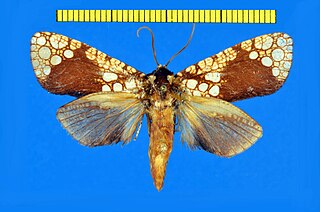
Dudgeonea is a small genus of moths and the only genus of its family, the Dudgeoneidae. It includes six species distributed sparsely across the Old World from Africa and Madagascar to Australia and New Guinea.
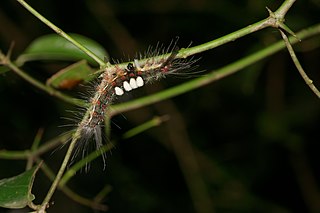
The Lymantriinae are a subfamily of moths of the family Erebidae. The taxon was erected by George Hampson in 1893.

The tawny frogmouth is a species of frogmouth native to and found throughout the Australian mainland and Tasmania. It is a big-headed, stocky bird, often mistaken for an owl due to its nocturnal habits and similar colouring, and is sometimes, at least archaically, referred to as mopoke or mopawk, also used for the Australian boobook, whose call is often confused with the tawny frogmouth's. In 2019, Australian readers of The Guardian online voted it as the second most popular bird in the Australian Bird of the Year poll. Its specific epithet is derived from the Latin strix meaning "owl" and oides meaning "form". Tawny frogmouths belong to the frogmouth genus Podargus, which includes the two other species of frogmouths found within Australia, the marbled frogmouth and the Papuan frogmouth. The frogmouths form a well-defined group within the order Caprimulgiformes. Although related to owls, their closest relatives are the oilbirds, potoos, owlet-nightjars, and true nightjars. The earliest fossil evidence of frogmouths is from the Eocene and implies that they diverged from their closest relatives during the early Tertiary. Three subspecies of the tawny frogmouth are currently recognised:

Gracillariidae is an important family of insects in the order Lepidoptera and the principal family of leaf miners that includes several economic, horticultural or recently invasive pest species such as the horse-chestnut leaf miner, Cameraria ohridella.

Choreutidae, or metalmark moths, are a family of insects in the lepidopteran order whose relationships have been long disputed. It was placed previously in the superfamily Yponomeutoidea in family Glyphipterigidae and in superfamily Sesioidea. It is now considered to represent its own superfamily. The relationship of the family to the other lineages in the group "Apoditrysia" need a new assessment, especially with new molecular data.
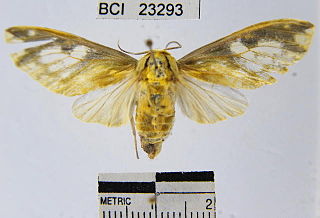
Castrica is a genus of moths in the family Erebidae. The genus was erected by William Schaus in 1896.

The Thyatirinae, or false owlet moths, are a subfamily of the moth family Drepanidae with about 200 species described. Until recently, most classifications treated this group as a separate family called Thyatiridae.
Grapevine moth or Grape moth may refer to:

Phalaenoides glycinae is a moth of the family Noctuidae that is native to southeastern Australia.

Scythris is a genus of gelechioid moths. It is the type genus of the flower moth family, which is sometimes included as a subfamily in the Xyloryctidae, or together with these merged into the Oecophoridae. The genus was erected by Jacob Hübner in 1825.
In the 10th edition of Systema Naturae, Carl Linnaeus classified the arthropods, including insects, arachnids and crustaceans, among his class "Insecta". Insects with net-veined wings were brought together under the name Neuroptera.
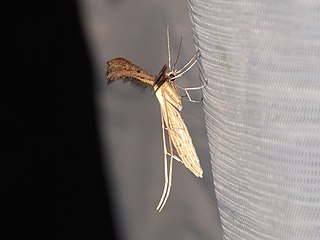
Pterophorinae is a subfamily of moths in the family Pterophoridae.

The spotted caddis fly is a species of caddisfly in the Phryganeidae family. It is found in Fennoscandia, Poland, the Baltic region, Belarus and Russia.

Castrica phalaenoides is a moth of the family Erebidae first described by Dru Drury in 1773. It is found in Mexico, Guatemala, Panama, Honduras, Costa Rica, Brazil, French Guiana, Peru, Venezuela, Ecuador and Trinidad.
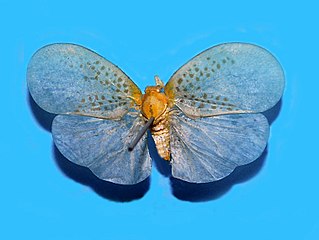
Poekilloptera is a genus of insects in the Flatidae family of planthoppers.
